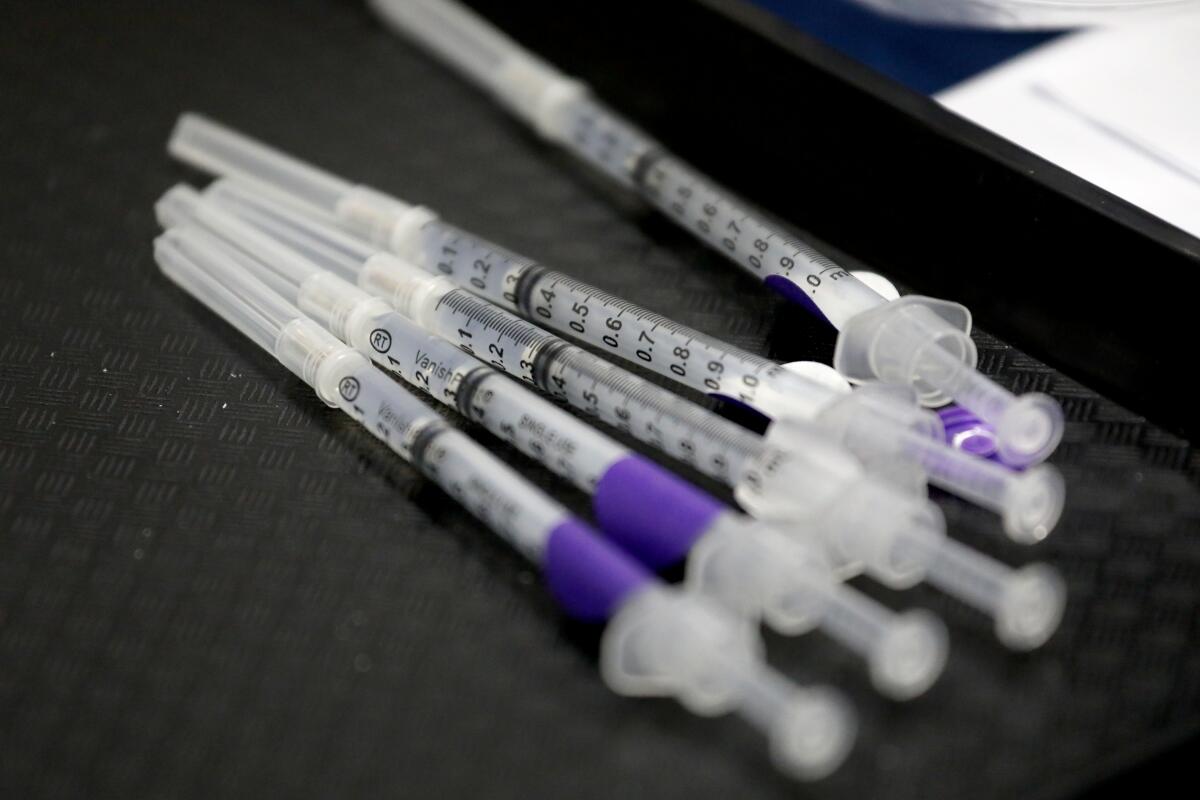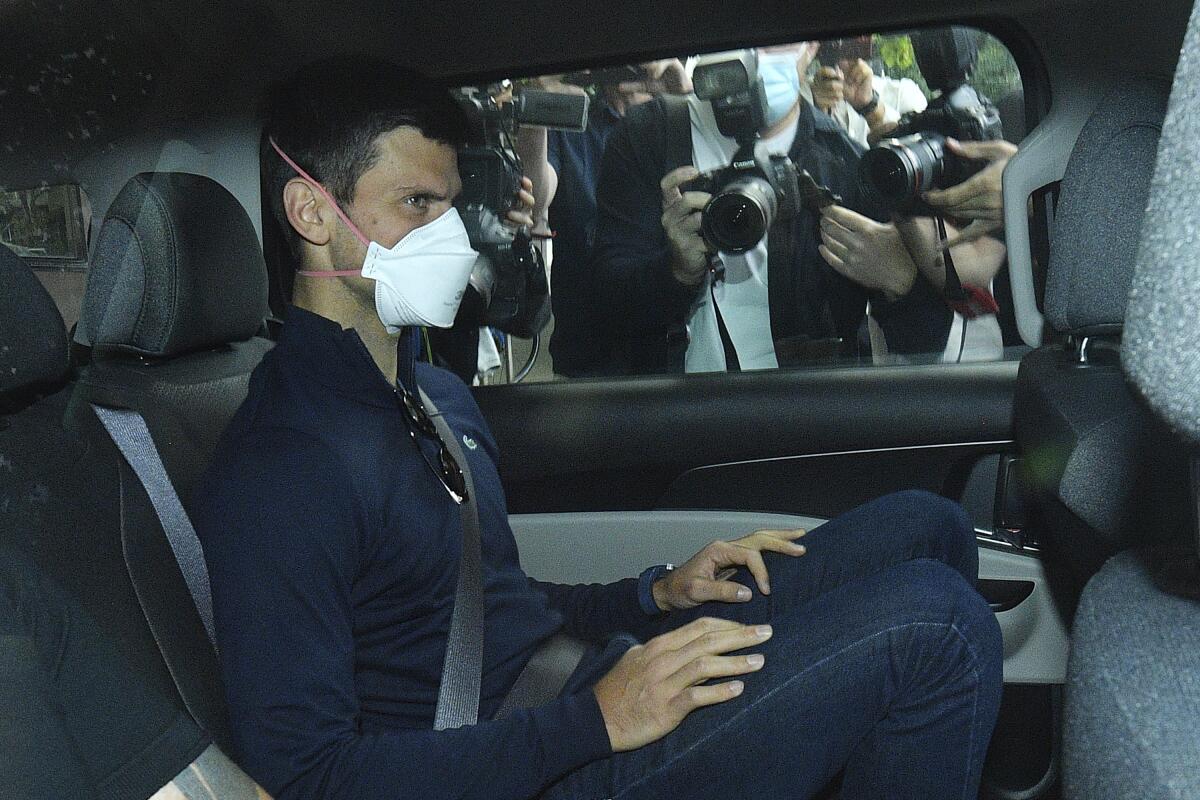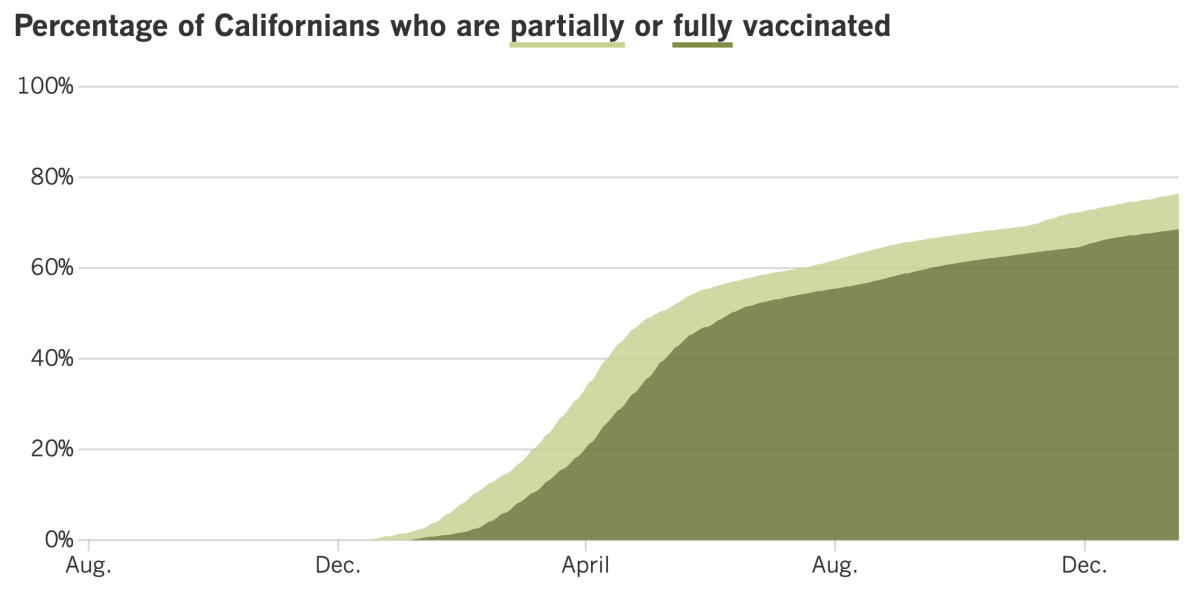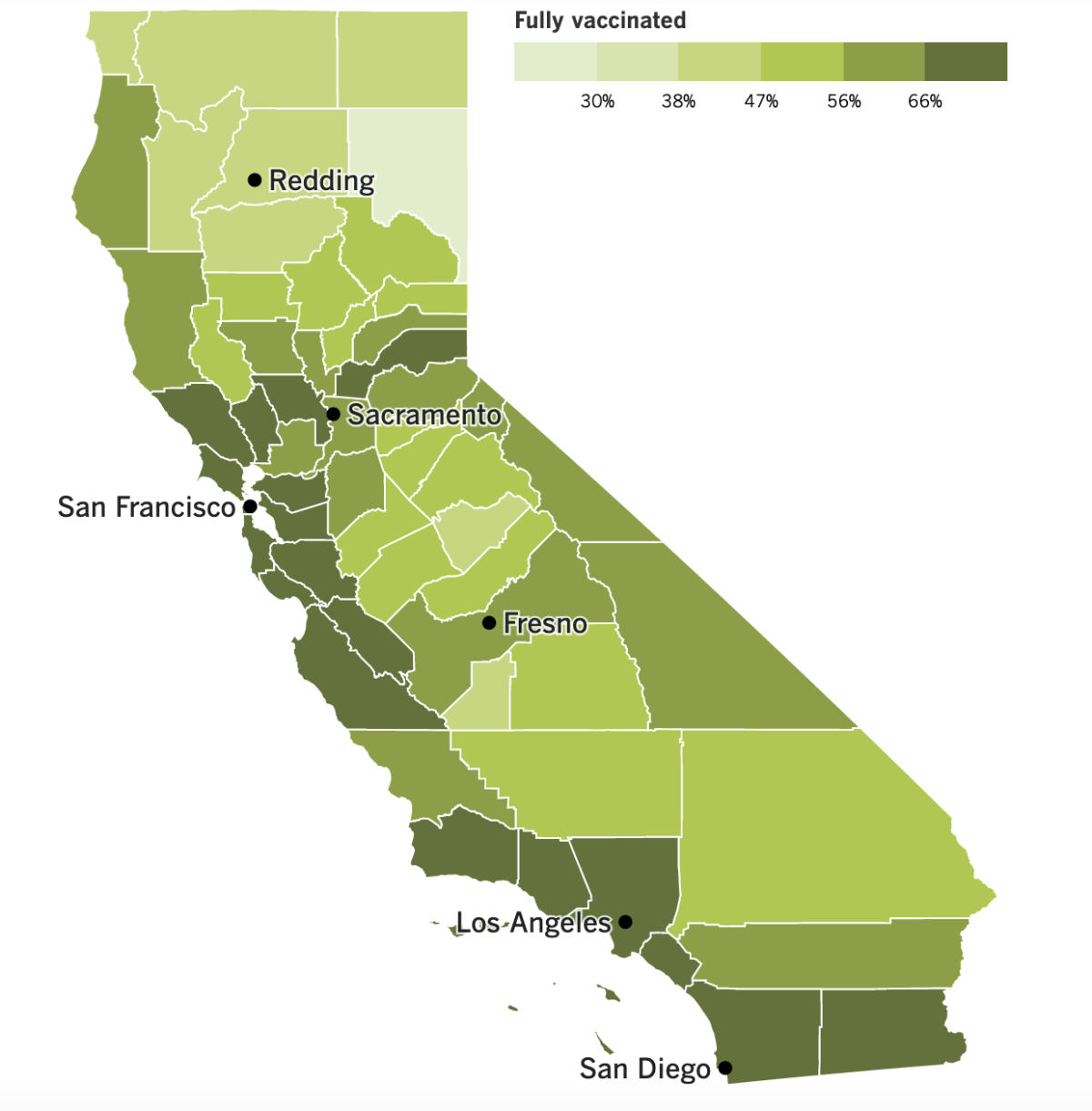Coronavirus Today: No vaccine, no custody?
- Share via
Good evening. I’m Karen Kaplan, and it’s Tuesday, Jan. 18. Here’s the latest on what’s happening with the coronavirus in California and beyond.
When divorced parents go to family court to hash out child custody arrangements, judges have paid special attention to mothers and fathers who smoke. In some cases, cigarette smokers have been ordered to stop smoking in their homes for a day or two before their child visits. In other cases, smokers have been denied custody altogether.
“The very fact that you would continue smoking around the child, knowing the risk, knowing how widely publicized the risks are, suggests to me a lack of concern” for a child’s health, said John F. Banzhaf III, a professor emeritus of public interest law at George Washington University Law School.
Could the same logic apply to parents who refuse to get vaccinated against COVID-19?
In Banzhaf’s view, it certainly could. People who smoke pose a risk to those nearby in the form of secondhand smoke. Likewise, people who are unvaccinated pose a risk to those around them because they’re much more likely to be infected with the coronavirus — and to infect others.
In fact, Banzhaf told my colleague Emily Alpert Reyes, the evidence that it’s dangerous for a child to be around an unvaccinated parent “is far clearer than we used to have with regard to secondhand tobacco smoke.”
He’s not the only one who sees things this way. A judge in Chicago barred a divorced mother from seeing her 11-year-old son until she got vaccinated against COVID-19. The boy could remain with his vaccinated father in the meantime, the judge said. (After the case was featured on the local TV news, the judge rescinded his order and recused himself from the case.)
Another judge in New York suspended parental visits for an unvaccinated father unless he got the shots or agreed to regular coronavirus testing.
“The danger of voluntarily remaining unvaccinated during access with a child while the COVID-19 virus remains a threat to children’s health and safety cannot be understated,” wrote the judge, Matthew F. Cooper.

The father’s attorney said it was one thing for the court to make a medical decision on behalf of a child but quite another to make a medical decision for an adult.
Cooper framed things differently. In his view, the question wasn’t whether the court had the authority to require an adult to be vaccinated but whether the court would allow the mother to make COVID-19 vaccination or coronavirus testing a condition for the father seeing their daughter.
Rachel Rebouché, a family law expert and interim dean at Temple University Beasley School of Law, said it’s not yet clear whether judges have the authority to deny custody to unvaccinated parents. Courts are supposed to determine whether parents are able to care for their children, and that includes protecting them from diseases, she said. That means a parent’s vaccination status is at least relevant.
The fuzziness of the situation was evident recently in the courtroom of Los Angeles County Superior Court Judge Harvey A. Silberman. A vaccinated mother and unvaccinated father agreed with Silberman that their young son should be immunized. But then the judge warned the father that if he didn’t do the same, “you could very well lose time with your child.”
The father said he had a medical issue that prevented him from getting vaccinated, but Silberman wasn’t buying it. “I want to know what the medical evidence is,” he said during the hearing. “This child needs to be protected.”
The father’s attorney, Alphonse Provinziano, said a case like this could end up in the state Supreme Court. If a parent has a legitimate medical reason to skip the vaccine, “you can’t use that disability to say that you’re somehow unable to be a parent to your child,” he said.
The mother’s attorney, Patrick Baghdaserians, said he hadn’t raised the issue with Silberman and was pleasantly surprised by the judge’s warning. If the order is ignored, Baghdaserians said, his client would seek a change in her child’s custody arrangement.
“If one of the parents is not vaccinated, that potentially exposes the child to harm,” he said.
By the numbers
California cases and deaths as of 5:09 p.m. Tuesday:

Track California’s coronavirus spread and vaccination efforts — including the latest numbers and how they break down — with our graphics.
Australia 1, Novak Djokovic 0
Novak Djokovic, the top-rated men’s tennis player in the world, arrived in Melbourne on Jan. 6 with one goal in mind: winning the 2022 Australian Open.
Any professional tennis player wants to win any tournament they enter. But this one held special significance for the 34-year-old athlete. Djokovic is the defending champion, having bested Russia’s Daniil Medvedev in a three-set final last year. More importantly, another tournament win would give Djokovic his 21st career Grand Slam title, putting him ahead of longtime rivals Roger Federer and Rafael Nadal. (All three are currently tied at 20.)
Yet for all his preparation — hitting countless groundstrokes, following a gluten-free diet, and practicing mindfulness exercises — there was one thing he neglected: getting a COVID-19 vaccine.
It wasn’t a huge surprise. Djokovic has a history of downplaying the coronavirus threat. In 2020, while the ATP Tour was suspended for safety reasons, he organized his own four-city tennis event but had to pull the plug after he, his wife and multiple players tested positive for infections. He has also expressed skepticism about vaccines in general and said he “wouldn’t want to be forced by someone to take a vaccine” in order to compete in tournaments.
Unfortunately for him, the Australian government requires foreign visitors to be vaccinated against COVID-19. If they’re not, they can request an individual exemption, though the circumstances that warrant one are narrow and don’t apply to his situation.
The result is that Djokovic’s latest stay in the land Down Under included more time in court than on one, as my colleague Helene Elliott put it.
His visa to enter Australia was canceled shortly after after his plane touched down in Melbourne on Jan. 5. Elliott explained that the visa never should have been granted to start with; it got through because Australian Open tournament director Craig Tiley thought the tennis star didn’t need the vaccine because he’d already had COVID-19.
Djokovic’s visa was reinstated on procedural grounds, though he spent four nights in immigration detention and was later confined to an immigration hotel. The visa was canceled a second time on Friday, and that decision became final on Sunday when a court dismissed his challenge to a deportation order.
“I am extremely disappointed with the Court ruling ... which means I cannot stay in Australia and participate in the Australian Open,” Djokovic said in a statement. “I am uncomfortable that the focus of the past weeks has been on me and I hope that we can all now focus on the game and tournament I love.”

The part about being disappointed is surely sincere. His concern for everyone else involved in the tournament? Maybe not so much.
Elliott pointed out that Djokovic lied on an immigration form by saying he hadn’t visited any other countries in the two weeks before he landed in Australia; in fact, he had been in Serbia and Spain. Djokovic blamed the discrepancy on an “administrative mistake” made by his agent.
On top of that, after testing positive for another coronavirus infection in December, he went ahead with an interview and photo shoot with the French sports publication L’Equipe. He later acknowledged that was “an error of judgment.”
The Australian public is largely in favor of the decision to deport Djokovic, with 71% supporting it in one survey and 83% backing it in another.
The country of 25.7 million has endured some of the world’s strictest COVID-19 lockdown measures, which has helped keep the death toll there to just 2,826 since the pandemic began, according to Johns Hopkins University. (For the sake of comparison, Texas has 29.5 million residents and 76,000 deaths, according to the Centers for Disease Control and Prevention.) Allowing a celebrity to play by different rules just didn’t sit right, especially while hospitals in Melbourne are in emergency status thanks to a flood of COVID-19 patients and an extreme shortage of workers.
Djokovic isn’t the only professional tennis player who’s unvaccinated, but he’s the only one who tried to sneak into the Australian Open; two other would-be contenders just stayed home, Elliott noted.
“It is Djokovic’s right to remain unvaccinated, debatable and arguably irresponsible though that is. But he must accept the consequences of his choice,” she wrote.
Djokovic may face similar obstacles at the French Open, Wimbledon and the U.S. Open. A new French law that requires people to have proof of vaccination to enter public places would prevent an unvaccinated player from competing at Roland Garros, the French Sports Ministry said Monday. And under current U.S. rules, Djokovic would need an exemption to fly into New York City (or any other airport here).
He might have a shot at playing at Wimbledon. England currently accepts unvaccinated travelers as long as they test negative for a coronavirus infection before they arrive, quarantine for 10 days when they get there, and test negative two more times during the quarantine period. It’s possible the All England Lawn Tennis Club, which hosts the Wimbledon tournament, will impose stricter rules for players. The club hasn’t made any guarantees that Djokovic can play there this year, according to media reports.
Australia’s deportation orders usually prohibit offenders from returning to the country for three years. If that’s the case for Djokovic, he would be 37 the next time he gets a chance to play for the Australian Open title. The last time a 37-year-old won the men’s title was in 1972.
California’s vaccination progress


See the latest on California’s vaccination progress with our tracker.
Your support helps us deliver the news that matters most.
In other news ...
How fast does Omicron spread? Fast enough to cause California to log 1 million new coronavirus cases in a single week.
The state just crossed the 6 million mark on Jan. 10. This Monday, the running tally hit 7 million. It was the fastest accumulation of reported infections since the pandemic began.
In part, that’s a testament to Omicron’s transmissibility, which is at least twice that of Delta. But it also reflects the fact that Omicron has prompted more people to get tested more often, so when infections occur, they have a better chance of being counted.
Los Angeles County alone had 31,576 new cases on Monday — a nearly tenfold increase compared with a month ago. Even that total could have been an undercount due to reporting delays on Martin Luther King Jr. Day and over the holiday weekend.
All those infections have fueled an influx of patients in local hospitals. At Arrowhead Regional Medical Center in Colton, some people were forced to camp out in the emergency room for days before inpatient beds opened up. ICU nurses who normally care for two patients at a time have had to cover three because so many of their co-workers were out sick. The unfortunate managers in charge of scheduling staff likened the challenge to a game of Tetris.
COVID-19 deaths are also up across the state. California has averaged 106 deaths per day over the last week; during the last week of 2021, the average was 55 deaths per day. (At the height of last year’s fall-and-winter surge, the state averaged 545 deaths per day.)
That pattern, too, is mirrored in L.A. County. As of Tuesday, the county averaged just under 41 deaths per day over the last week. The prior week, that figure was 20. (The peak last year was about 240 deaths per day.)
Last week, officials said that although Omicron was responsible for the bulk of new infections, the Delta variant was probably to blame for most hospitalizations and deaths. Now, however, most of the people who are dying of COVID-19 became ill when Omicron was the dominant strain.
“Let’s not fool ourselves by not recognizing the danger presented by the Omicron variant, which is capable of spreading with lightning speed and causing serious illness among our most vulnerable residents,” said L.A. County Public Health Director Barbara Ferrer.
And it will get worse before it gets better. Across the country, the wave of COVID-19 deaths is expected to crest in late January or early February, with a weekly death toll equal to or greater than that of the Delta peak. Somewhere between 50,000 and 300,000 more Americans are likely to die before the Omicron wave subsides in mid-March, epidemiological models indicate.
“This is Omicron-driven,” said Katriona Shea of Pennsylvania State University, who co-leads a team that pulls together several pandemic models and shares the combined projections with the White House.
The most effective defense against Omicron — and any other variant — is to get more people immunized. In Greece, the government imposed a new vaccine mandate for residents 60 and older because people in that age group are the most likely to wind up seriously ill.
The mandate comes with a financial penalty for those who fail to comply — a $57 fine in January, which will rise to $114 a month after that. Greece’s tax office will collect the fines, and the money will help fund state hospitals.
And finally, the families of healthcare workers in India who died after caring for COVID-19 patients are finding that the government isn’t living up to its pledge to take care of the survivors.
Doctors, nurses, hospital porters and other medical workers who contracted the disease on the job were promised a package worth $67,000 if they died. It was a way to honor “corona warriors,” many of whom work in the private sector and were drafted into the fight. Now, relatives are being told the funds are only for staff at public COVID-19 facilities.
That hardly seems fair to Amanjit Singh, then 17, whose father was ordered to reopen his shuttered family practice clinic in Mumbai. He died within days, as did Singh’s mother. It took nine months for the teen to navigate the Indian bureaucracy and get a copy of his dad’s death certificate to document his cause of death. But he was turned down anyway because his father was a private practitioner.
“I have no energy to try again,” Singh, now 19, said.
Your questions answered
Today’s question comes from readers who want to know: If I test positive for a coronavirus infection with an at-home test, do I need to report it to someone?
Now that test kits are getting a little easier to come by, odds are decent that you or someone else in your household will discover an active infection when two pink lines materialize on the test strip instead of just one.
If that happens to you, you should isolate at home for at least five days and wear a mask when you’re around others for at least 10 days. (The CDC has more specifics.)
You’ll also have some calls to make. One of them should be to your healthcare provider. Others should be to people you’ve been in close contact with over the last few days.
To be more specific: A close contact is someone who’s been within 6 feet of you for a total of 15 minutes over the course of a 24-hour period. Think back to all the people who fit that bill going back to two days before you experienced any COVID-19 symptoms yourself — you could have been contagious all that time. If you’re asymptomatic, just inform close contacts from the 48-hour period before you took the home test.
If you need help reaching out to those you may have infected, call the L.A. County Department of Public Health for assistance. The number is (833) 540-0473.
But you don’t need to call that hotline just to let authorities know you’ve tested positive. The results from at-home tests generally aren’t included in official case counts, since the results may not be as accurate as with tests processed by a professional lab.
The public health department definitely doesn’t want you to call if you’ve tested negative.
We want to hear from you. Email us your coronavirus questions, and we’ll do our best to answer them. Wondering if your question’s already been answered? Check out our archive here.
Resources
Need a vaccine? Here’s where to go: City of Los Angeles | Los Angeles County | Kern County | Orange County | Riverside County | San Bernardino County | San Diego County | San Luis Obispo County | Santa Barbara County | Ventura County
Practice social distancing using these tips, and wear a mask or two.
Watch for symptoms such as fever, cough, shortness of breath, chills, shaking with chills, muscle pain, headache, sore throat and loss of taste or smell. Here’s what to look for and when.
Need to get a test? Testing in California is free, and you can find a site online or call (833) 422-4255.
Americans are hurting in many ways. We have advice for helping kids cope, resources for people experiencing domestic abuse and a newsletter to help you make ends meet.
We’ve answered hundreds of readers’ questions. Explore them in our archive here.
For our most up-to-date coverage, visit our homepage and our Health section, get our breaking news alerts, and follow us on Twitter and Instagram.




